Worksop PrioryFeatures and Fittings
  In the east wall of the north transept is a shaft piscina, fixed there in 1935 in memory of Mr Leonard Day, first Head of the Priory Higher School from 1912 until 1933. In the east wall of the north transept is a shaft piscina, fixed there in 1935 in memory of Mr Leonard Day, first Head of the Priory Higher School from 1912 until 1933.

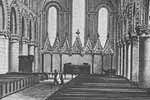 The reredos in its The reredos in its
original location, c.1870 |
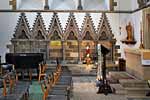 The reredos in the The reredos in the
north transept |
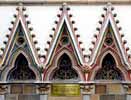 Detail of reredos Detail of reredos
after conservation |
Sir Gilbert Scott’s reredos, installed in the east end c.1858, is now located in the north transept, whence it was moved in 1935 or soon after. Its stone arcades and marble shafts set off its rich colours and gilding; cleaned and conserved in 2019.
In 2023 the pigments were analysed using Raman spectroscopy and a paper describing the results may be freely downloaded from here: doi.org/10.3390/heritage6070269

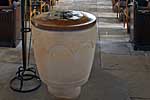 Modern font Modern font |
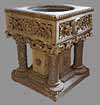 C19th font C19th font |
The very plain stone font is by Laurence King, and dates from 1974. It replaces a C19th font in the Gothic style, which has been placed in the south-west corner of the nave. Standing on an octagonal base with outer pillars, it is carved in high relief with foliage surrounding the four figures of the tetramorph, namely a winged man representing Matthew, a winged lion representing Mark, a winged ox representing Luke and a winged eagle representing John. It has an oak cover.
  The brass lectern, in the form of an eagle, is in memory of the Revd Thomas Stacye, and dates from 1847. The inscription states: The brass lectern, in the form of an eagle, is in memory of the Revd Thomas Stacye, and dates from 1847. The inscription states:
IN PIAM MEMORIAM THOMAE STACYE
A.M. PER 54 ANNOS HVJVS PAROCHIAE DE
WORKSOP VICARII QVI IN JESU OBDORMIVIT
280 DIE JANU A.D. 1847. AETAT: SVAE 900
HOC LECTRINVM POSVIT NATVS EJVS VNICVS J.S. |
 The metalwork corona, which hangs over Laurence King’s Altar, contains pieces of unworked crystal, and may be by John Haywood. The metalwork corona, which hangs over Laurence King’s Altar, contains pieces of unworked crystal, and may be by John Haywood.

In terms of furnishings, there is a sixteenth or seventeenth century coffer near the font and an oak table of similar period in the south transept. There is an eighteenth century side table with a drawer and turned legs near the modern font. A small number of eighteenth century pews survive in the Lady Chapel and there are some nineteenth century pews in the nave, along with some nineteenth century chairs in the north transept.
 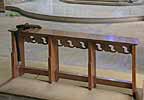 The light oak altar rails at the crossing were given in memory of Charles Rule Walton and his wife in July 1960. An inscription on the top reads: The light oak altar rails at the crossing were given in memory of Charles Rule Walton and his wife in July 1960. An inscription on the top reads:
TO THE GLORY OF GOD
AND IN LOVING MEMORY OF CHARLES RULE WALTON
WHO SANG IN THIS CHOIR FOR THIRTY TWO YEARS
AND OF HIS WIFE MARY ELIZABETH
R . I . P
JULY 1960 |
  Hanging in the arch between the south transept and the Lady Chapel is a very intricately carved depiction of the Crucifixion, with Christ on the cross flanked by Our Lady and St John. Hanging in the arch between the south transept and the Lady Chapel is a very intricately carved depiction of the Crucifixion, with Christ on the cross flanked by Our Lady and St John.
It is of excellent quality, possibly northern European in origin.
  Under the central east window in the Lady Chapel is a fine sculpture of the Crucifixion, again showing Christ flanked by Our Lady and Saint John. By an unknown artist, it fits so well between the arches that it seems likely to have been commissioned for the location. Under the central east window in the Lady Chapel is a fine sculpture of the Crucifixion, again showing Christ flanked by Our Lady and Saint John. By an unknown artist, it fits so well between the arches that it seems likely to have been commissioned for the location.
  The communion rails in the Lady Chapel were given in memory of Herbert and Agnes Salmon in 1956. The communion rails in the Lady Chapel were given in memory of Herbert and Agnes Salmon in 1956.
 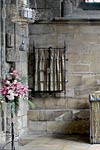 There is an aumbry in the east wall of the Lady Chapel, behind curtains and an elegant wrought-iron screen. There is an aumbry in the east wall of the Lady Chapel, behind curtains and an elegant wrought-iron screen.
It is dedicated ‘In memory of Maria Salmon 1888-1972’.
| 





















